Visit The Gopachal Parvat To Explore Its History And Architecture In 2025
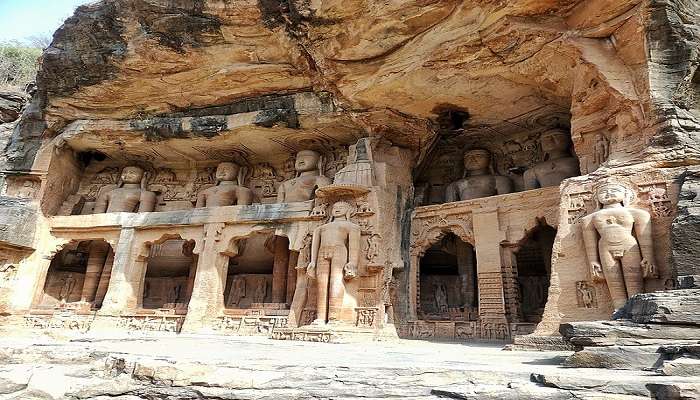
Nestled in the heart of Gwalior, Gopachal Parvat stands as a testament to ancient Indian artistry and spiritual devotion. This rocky hill, adorned with massive Jain sculptures carved directly into its face, offers visitors a bygone era of religious fervour and artistic mastery. Dating back to the 15th century, Gopachal Parvat is home to an impressive array of Jain Tirthankar statues, each telling a story of dedication and craftsmanship. These colossal figures, some towering over 58 feet tall, were painstakingly carved during the reign of the Tomar dynasty, a period known for its patronage of art and architecture.
About Gopachal Parvat

Gopachal Parvat, translated to “Cowherd Mountain” in Hindi, is a historic site on the eastern face of the Gwalior Fort in Madhya Pradesh. It’s famous for its collection of Jain rock-cut monuments carved between the 7th and 15th centuries.
The carvings depict Tirthankaras, the spiritual leaders in Jainism, in various meditation postures. These figures range from 2 meters to a staggering 14 meters tall, the most prominent being a 47-foot (14-meter) idol of Parshvanatha, considered the largest Parshvanatha idol in lotus posture.
According to Jain traditions, Parshvanatha delivered his spiritual discourse (deshna) on this hill, adding to the site’s religious significance. The complex also includes 26 Jain temples, some on the hilltop and others at the base. Gopachal Parvat thus offers a glimpse into Jain art and culture with its colossal sculptures and serene atmosphere.
Must Read: Places To Visit Near Gwalior
History Of The Gopachal Parvat
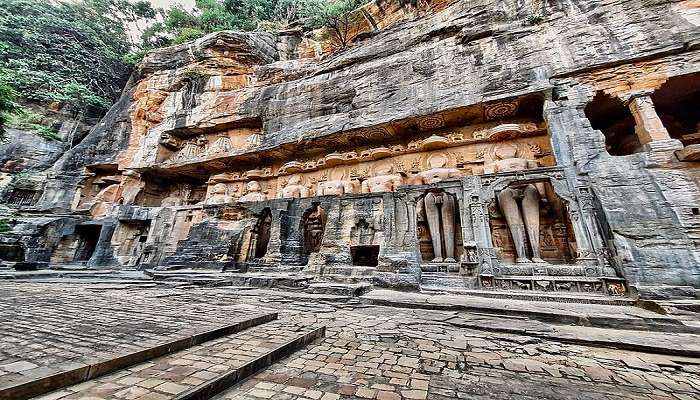
The Gopachal rock-cut monuments form part of a cluster of nearly 100 Jain structures surrounding Gwalior city. These monuments predate the Siddhachal Caves, located approximately 2 Km north. 1527 Emperor Babur ordered their defacement and destruction in 1527. He specifically mentioned mutilating the Urvahi Jinas in his memoirs.
Centuries later, the Jain community restored statues by adding stucco heads to repair the damage inflicted during Babur’s reign. Raidhu, a prolific Apabhramsha author, is credited with consecrating numerous Jain rock-carved images, as evidenced by multiple inscriptions. Among these are the colossal images of Shri Adinatha (57 feet) and Shri Chandraprabhu.
The fort of Gwalior has seen various rulers: Qutb ud-Din Aibak captured it from the Pratiharas in 1196, Altmash fortified the Urvahi gate in 1232, and the Tomars ruled from 1394 to 1517. Mughal Emperor Babur conquered Gwalior in 1527 and ordered the destruction of Jain statues, particularly at the Urvahi gate and Ek Patthat ki Bawadi, where the heads were damaged. Subsequently, Jain temples were reconstructed in Gwalior around 1704, including the Jain Golden Temple, after the Maratha Scindia clan took control in 1731.
Architecture Of Gopachal Parvat
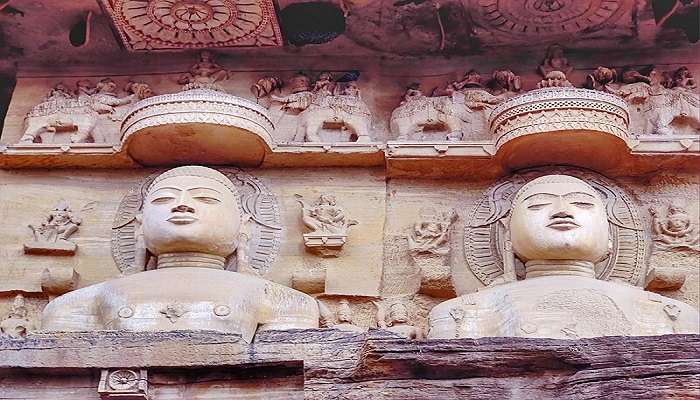
Gopachal Parvat represents Jain craftsmanship and heritage in central India. This site encompasses a complex of rock-cut Jain monuments dating from the 7th to 15th centuries, each revealing distinct historical and architectural nuances.
The architectural marvels at Gopachal Parvat include clusters of rock-cut caves spread across its expanse. The Southeast group, Ek Patthar Ki Bawadi, comprises 26 interconnected caves spanning half a mile. Renamed Gopachal Atishya Kshetra, this group features inscriptions dating back to 1468-1473 AD, offering insights into that era’s religious and cultural life. Adjacent to it, the South-West group called Trishalagiri houses some of Gwalior’s oldest Jain monuments, dating from the post-Gupta period. The Urvahi group, dating from 1440-1453 AD, lines the road through the Urvai Gate with visible rock-cut structures and six inscriptions detailing its historical significance.
The North-West group, named after Lord Naminath, features a 1470 AD inscription and well-preserved monumental images of Jain deities, while the North-East group, named after Lord Neminath, completes the ensemble, contributing further to the architectural richness surrounding Gopachal Parvat. Central to this complex are the monumental Jain sculptures carved directly into the eastern face of the hill. These sculptures, ranging from 2 to 10 meters in height, depict Jain Tirthankaras in meditation postures, symbolising detachment from worldly attachments. Despite damage in the 16th century, ongoing restoration efforts, including adding stucco heads to some idols, ensure that these artistic treasures continue to inspire awe and reverence today.
Suggested Read: Things To Do In Gwalior
Gopachal Parvat Timings And Entrance Fees
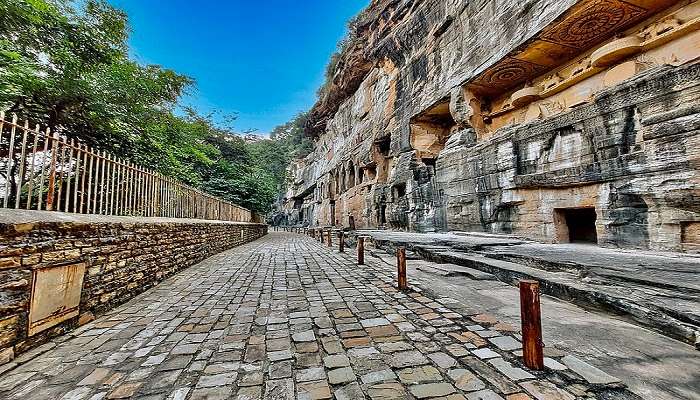
The good news for visitors is that Gopachal Parvat boasts extended hours and is possibly open 24/7.
This means you can plan your visit at your convenience, whether you prefer the calmness of early mornings or the serenity of evenings. Another positive aspect is that entry to Gopachal Parvat is reportedly free for domestic and international visitors. This makes the historical and religious site an accessible and budget-friendly tourist destination.
Best Time To Visit
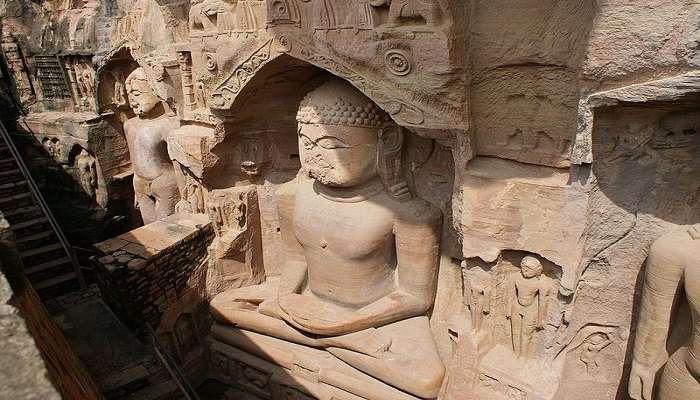
The best time to visit Gopachal Parvat is from October to March. The reason behind this is:
Pleasant Weather: Gwalior experiences a dry climate. The summer months, from April to June, can be scorching, with temperatures exceeding 40°C, making sightseeing quite uncomfortable. The monsoon season arrives in July and lasts until September. While the rains add a touch of beauty, they can also disrupt outdoor activities. October onwards, however, welcomes a much-needed respite. The temperatures settle into a comfortable range, between 8°C and 28°C, perfect for exploring the intricate carvings and sprawling complex of Gopachal Parvat.
Clear Skies and Unobstructed Views: Winter offers the additional benefit of clear blue skies. This translates to excellent visibility, allowing you to appreciate the intricate details of the colossal Jain sculptures and the surrounding landscape in all its glory.
Tourist Season: October also marks the beginning of the festive season in India. If you visit during this time, you might have the opportunity to witness vibrant local celebrations and immerse yourself in the region’s rich cultural tapestry.
Suggested Read: Places To Visit In Gwalior
How To Reach
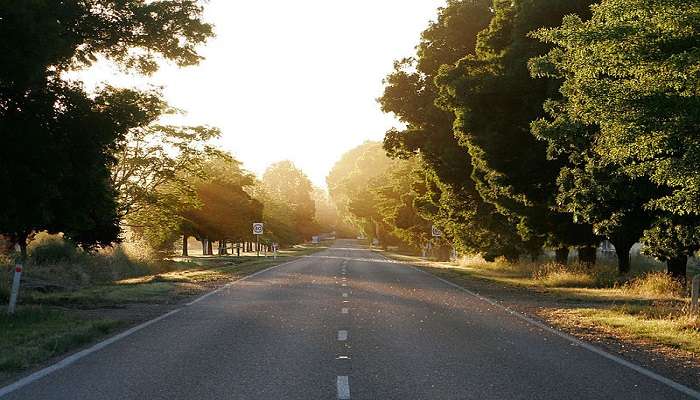
There are three main ways to reach Gopachal Parvat. They are as follows:
By Road
Gwalior is well connected by road to major cities in India. National Highways NH 75 and NH 25 pass through Gwalior. You can easily reach Gwalior by car or taxi if you travel from nearby cities like Agra (213 Km) or Jhansi (102 Km). You can also take a bus from many other cities in India. Once you reach Gwalior, you can take an auto-rickshaw or taxi to Gopachal Parvat. It is located on the foothills of Gwalior Fort, and you can either drive up to the Gopachal Parvat complex or climb the stairs to reach the Jain temples.
By Train
Gwalior Junction Railway Station (GWL) is a major railway station on the Delhi-Mumbai route. Several trains connect Gwalior to other Indian cities. Once you arrive at Gwalior Junction Railway Station, you can take an auto-rickshaw or taxi to Gopachal Parvat. The distance is about 2 Km away.
By Air
Gwalior has Raja Bhoj Airport (GWA), about 10 kilometres from the city centre. Regular flights from Delhi, Mumbai, and other major Indian cities go to Gwalior. After landing at Raja Bhoj Airport, you can take a taxi or rent a car to reach Gopachal Parvat.
Further Read: Temples In Gwalior
Gopachal Parvat shows the rich culture and art of ancient India. Its giant Jain sculptures, carved with great detail and care, let visitors see the spiritual greatness of the past. When you see these tall sculptures, you’ll be amazed by the talent and hard work of the artists who made them long ago. Are you excited to visit Gopachal Parvat? Ensure you don’t miss this fantastic site and other incredible places in Madhya Pradesh! Book your trip to Madhya Pradesh today and go on a journey through time, art, and spirituality that you’ll never forget!
For our editorial codes of conduct and copyright disclaimer, please click here.
Cover Image Credit: Vampireprodigy for Wikimedia Common
Frequently Asked Questions About Gopachal Parvat
What is Gopachal Parvat?
Gopachal Parvat, meaning Cowherd Mountain in Hindi, is a hill near the Gwalior Fort in Madhya Pradesh. It is famous for its Jain rock-cut monuments dating back to the 7th and 15th centuries.
What can you see at Gopachal Parvat?
Gopachal Parvat is renowned for its remarkable complex of Jain sculptures carved into the hill's rocks. These sculptures primarily depict Tirthankaras, revered spiritual figures in Jainism, captured in various postures. Among the notable sculptures is a colossal 47-foot (14-meter) statue of Parshvanatha, the largest idol of its kind, seated in the lotus position. Additionally, the site features sculptures of other Tirthankaras, such as Rishabhanatha, Neminatha, and Mahavir Swami. It also houses 26 Jain temples and a structure known as Trikal Chaubisi, which comprises chambers representing all 24 hours of the day.
What should I wear when visiting Gopachal Parvat?
Gopachal Parvat is a religious site, so it's important to dress modestly. For women, this means covering your shoulders and knees. A long skirt or dress with a loose-fitting top or kurti would be ideal. Men should wear long pants and a shirt or kurta.
Is photography allowed at Gopachal Parvat?
Photography is usually allowed at Gopachal Parvat, but certain areas might have restrictions. It's always best to ask permission before taking pictures, especially for ongoing religious ceremonies.
Are there any facilities available at Gopachal Parvat?
Small shops selling basic refreshments like water and snacks are present near the entrance. However, more developed tourist facilities will likely be found within the Gwalior Fort complex or in Gwalior city.
People Also Read:
Tourist Places In Madhya Pradesh Places To Visit In Madhya Pradesh In May Hill Stations In Madhya Pradesh

Innovative Content Writer Focused on Producing High quality, Original Content that drives traffic and engages readers. Experienced in Content strategy and analytics to measure content performance using tools such as SQL, Power BI, Excel.











